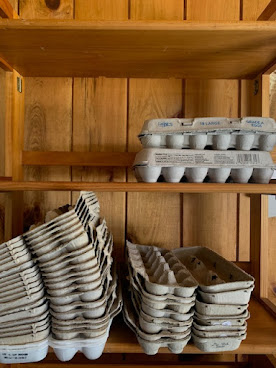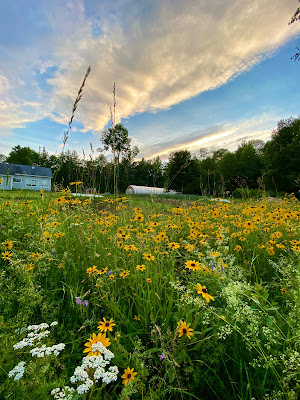MAPLE SYRUP
Ever wonder why real Maple Syrup is so expensive????
Well, its complicated.
Maple sugaring is not only extremely time consuming, but it is also expensive for the producer. The amount of equipment needed depends on the size of the operation, but much of what is required can potentially be quite expensive. Listed below are the basic steps involved in the sugaring process, and what is needed. While there is a lot more to the process than what is shown below, this should give you a better idea of just how much work is involved, and might make you appreciate that 'sweet stuff'' just a little bit more.


but first... some Farm News:
Here at CCF we had about 101 taps in 2018. We're hoping to increase this number in 2019 and start sugaring on our new property off the Hardscrabble Road. Most of the maple trees on the Hardscrabble lot are confined within a smaller area which should make the collection process less time consuming. In addition, we are thinking about hosting a sugaring day where our clientele can come view the maple sugaring process, and enjoy some fresh maple syrup!
What you need to know about maple sugaring:
"Perfect" Sap Running Conditions:
-early March/late February
-nights in the low 20's
-days in the high 40's
-low winds
-clear skies
-clear skies
Steps of production:
1. Collection
2. Boiling
3. Drawing Off
4. Canning
1. Collection
This step includes the set up of equipment and the extraction of maple sap from trees.
Methods of Collection:
-Buckets: "Old school way," use 3 gallon buckets (plastic or metal)
-Tubing Line: Plastic tube connects from tree-to-tree, more expensive way. Using this method requires a longer initial set up time, but once your lines are up they can be left up over the off season.
Here at CCF we use a combination of tubing line and plastic buckets.
Here at CCF we use a combination of tubing line and plastic buckets.
Tapping Procedure:
-1. drill hole 1.5 inches deep into tree with a 7/16" diameter drill bit (or 5/16" diameter depending on size of spile).
-2. attach a "spile" to allow sap to run out of tree in a bucket/tubing line
*sap collected once a day (in evening)!**
-"Maple tree stand"- cluster of maple trees
2. Boiling
During this process the raw sap is converted to a much denser liquid know as Maple Syrup.
Equipment:
-large pan over a fire- "old fashioned"
-small/large evaporator- multi chambered device that allows the sap to 'flow' from chamber to chamber as it becomes more 'dense'. The last chamber within the flow system is known as the 'draw off' or 'syrup chamber.'
-arch - pit or fire chamber that the evaporator sits on.
-arch - pit or fire chamber that the evaporator sits on.
-Some prefer to use a "Reverse Osmosis" machine which decreases the boiling time of the sap by sucking out most of its water content. This also makes the syrup lighter in color. Most back yard/hobby operations do not use RO as it is very expensive.
Here at CCF we use a stainless steal 2 X 6' evaporator over a wood fired arch. We do not use reverse osmosis.
Here at CCF we use a stainless steal 2 X 6' evaporator over a wood fired arch. We do not use reverse osmosis.
**When the boiling sap reaches 219 degrees Fahrenheit (7 degrees above water boils), it is officially MALE SYRUP!
3. Drawing Off
During this step, the hot maple syrup is filtered into a pot or vat after reaching 219 degrees Fahrenheit.
4. Canning
Maple Syrup should be hot during the canning process, so canning should occur directly after drawing off.
Steps:
1. Fill can or jar with hot Maple Syrup
2. Can should be tilted onto its side after filled with syrup. This will allow the can to seal.
3. Seal with lid.
These are the 4 main steps to the sugaring process!! As with anything, different producers of maple syrup may have different variations of this preparation process.
3. Seal with lid.
These are the 4 main steps to the sugaring process!! As with anything, different producers of maple syrup may have different variations of this preparation process.
Maple Syrup Grading
Another component of Maple Syrup is its grading process. The grading process is based on a particular syrup's color, age? and taste. This grading process may vary within different states.
New York State Grading:
-name: "New York Grade A Golden," lightest color with a delicate taste (early season/shorter boiling time)
-name: "New York Grade A Amber," light color with a rich taste (mid season/middle boiling time)
-name: "New York Grade A Dark Color," dark color with a robust taste (mid season/middle boiling time)
-name: "New York Grade A Very Dark Color," darkest color with a strong taste (late season/longest boiling time/most impurities)
This is just a quick overview of the Maple Syrup production process and the specific grading of the syrup. The point of this post is to emphasize how much time and effort it takes to produce maple syrup for the consumer... In fact it takes about 37 gallons of raw sap to equal 1 gallon of condensed maple syrup!! While it may take a lot of patience and money to produce a substantial amount of syrup, it sure is worth it on Sunday morning pancakes!!




Comments
Post a Comment